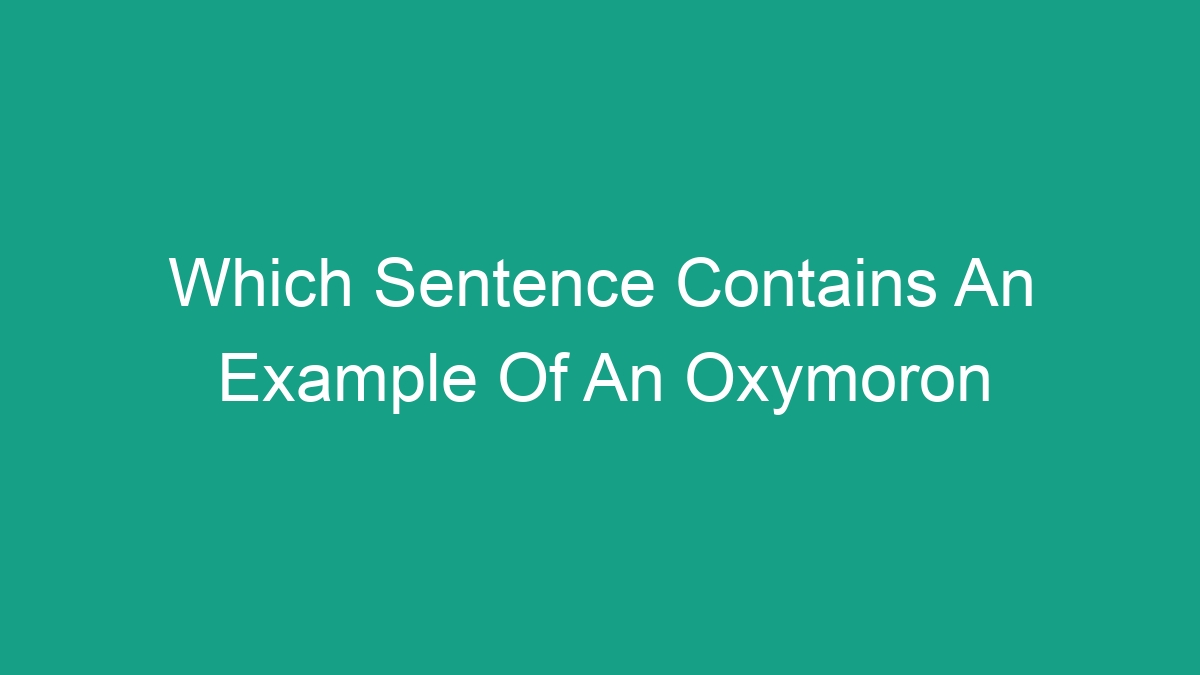
Understanding Oxymorons
An oxymoron is a figure of speech in which two contradictory terms are combined to create a rhetorical effect by paradoxical means. This literary device is commonly used in poetry, literature, and everyday language to produce a dramatic effect, create a humorous tone, or emphasize a point. Oxymorons can both surprise and engage the reader or listener by presenting a paradoxical combination of words. Let’s deep dive into understanding oxymorons and their usage in sentences.
Examples of Oxymorons in Sentences
1. “Living dead”
The term “living dead” is an example of an oxymoron because “living” and “dead” are opposing terms that have been combined to create a paradoxical expression. It is often used to describe someone who is alive but appears to be without emotional or spiritual life, such as a person who is apathetic or emotionally detached.
2. “Deafening silence”
“Deafening silence” is another classic example of an oxymoron. The juxtaposition of “deafening” and “silence” creates a contradictory image, as silence is commonly associated with quietness and absence of sound, while “deafening” implies a loud and overwhelming noise. This phrase is often used to describe a moment of complete stillness that is emotionally or psychologically overwhelming.
3. “Jumbo shrimp”
The phrase “jumbo shrimp” is a commonly used oxymoron in everyday language. While “jumbo” refers to something extremely large, “shrimp” typically denotes a small marine creature. By blending these contradictory terms, the phrase creates a humorous and memorable effect, often used in the context of seafood or food menus.
Significance of Oxymorons in Communication
Oxymorons play a significant role in communication by adding depth and nuance to language. They can evoke strong emotions, create a sense of irony, and emphasize conflicting ideas or emotions. Additionally, oxymorons can enrich literary works by adding complexity and intrigue to the text. They provide writers with a powerful tool to engage readers and convey intricate meanings within a few words.
Common Usage of Oxymorons
Oxymorons are widely used in various forms of communication, including literature, advertising, and everyday conversation. They serve as linguistic devices that capture attention, create a memorable impact, and enhance the overall effect of a message. In literature, authors often use oxymorons to highlight the contradictions and tensions inherent within characters or situations. In advertising, oxymorons are used to create catchy slogans or taglines that leave a lasting impression on the audience.
How to Identify Oxymorons in Sentences
Identifying oxymorons in sentences can be a fun and rewarding exercise. When analyzing a sentence, look for the juxtaposition of contradictory terms that create an unexpected or paradoxical effect. Pay attention to the emotional resonance of the phrase, as oxymorons often evoke strong feelings or cognitive dissonance. With practice, you can become adept at recognizing oxymorons in various forms of communication and appreciate their impact on language and expression.
Practical Applications of Oxymorons
Given their versatility, oxymorons can be effectively used in a wide array of contexts. They are especially valuable in creative writing, where they can add depth and complexity to characters, settings, and themes. In marketing and advertising, oxymorons can be used to create memorable slogans that capture the attention of consumers and leave a lasting impression. They are also useful in speeches and presentations, where they can underscore the nuances of complex ideas and make a persuasive impact on the audience.
Oxymorons in Literature
Many renowned authors have utilized oxymorons as a literary device to convey profound and thought-provoking ideas. From Shakespeare’s famous line “Parting is such sweet sorrow” to Oscar Wilde’s witty aphorism “I can resist everything except temptation,” oxymorons have left an indelible mark on literary works across different genres and time periods. Their ability to encapsulate conflicting emotions and paradoxical truths makes them a valuable tool for expressing the complexities of human experience in literature.
The Evolution of Oxymorons in Language
Language is dynamic and constantly evolving, and oxymorons have continued to adapt and thrive in contemporary communication. Whether in the realm of pop culture, social media, or digital marketing, oxymorons remain a potent and enduring element of linguistic creativity. As language continues to evolve, oxymorons will likely undergo further transformation, taking on new meanings and resonances in response to the evolving cultural and social landscape.
Conclusion
Oxymorons are powerful literary devices that add depth and complexity to language. By juxtaposing contradictory terms, they create a paradoxical effect that can evoke strong emotions, capture attention, and enrich communication. Whether used in literature, advertising, or everyday conversation, oxymorons play a significant role in shaping the way we perceive and engage with language. Their enduring presence in human expression reflects their timeless appeal and relevance in the ever-evolving landscape of communication.
FAQs
What is the purpose of using oxymorons in communication?
Oxymorons serve to create a paradoxical effect by juxtaposing contradictory terms, adding depth and nuance to language. They can evoke strong emotions, create a sense of irony, and emphasize conflicting ideas or emotions.
How can oxymorons be identified in sentences?
To identify oxymorons in sentences, look for the juxtaposition of contradictory terms that create an unexpected or paradoxical effect. Pay attention to the emotional resonance of the phrase, as oxymorons often evoke strong feelings or cognitive dissonance.
Where are oxymorons commonly used?
Oxymorons are commonly used in literature, advertising, and everyday conversation. They serve as linguistic devices that capture attention, create a memorable impact, and enhance the overall effect of a message.
What are some famous examples of oxymorons in literature?
Some famous examples of oxymorons in literature include Shakespeare’s line “Parting is such sweet sorrow” and Oscar Wilde’s aphorism “I can resist everything except temptation.”



